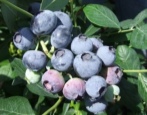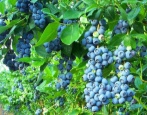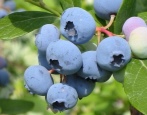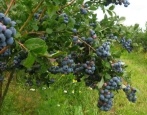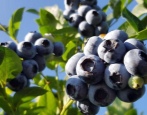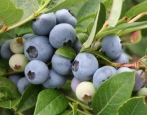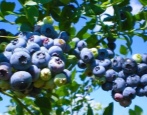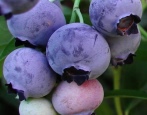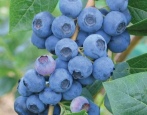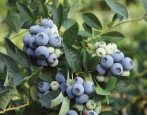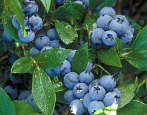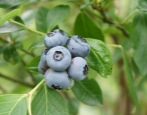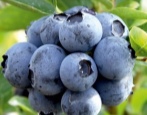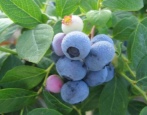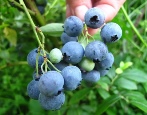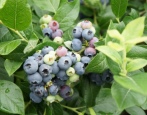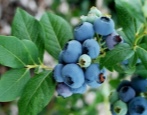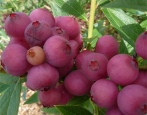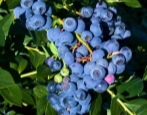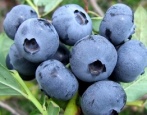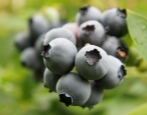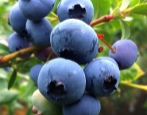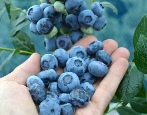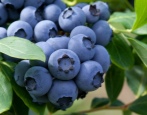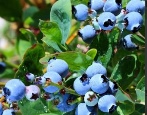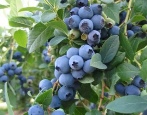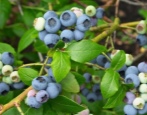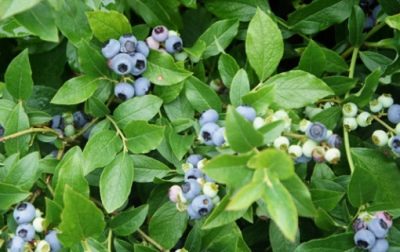
- Ripening terms: mid-early
- Growth type: undersized
- Bush height, m: 0,7-0,9
- Taste: pleasant, sweet
- Yield: medium
- Average yield: 1.2-2.0 kg per bush
- Fruit size: medium
- Fruit shape: somewhat flattened
- Fruit color: light blue
- Description of the bush: powerful, compact
North Country is a new and improved garden blueberry variety. Differs in high productivity and unpretentiousness to climatic conditions.
Berries are consumed fresh and used for processing, from which you can make jam, marshmallow, jelly, jelly, compote, dried fruits, freeze. The shrub is suitable for private and industrial cultivation. They are used in landscaping a garden, planted in flowerpots for decorating a terrace or veranda.
Breeding history
The variety was obtained in 1986 at the University of Minnesota.
Description of the variety
The bush is weak, 70-90 cm high, powerful and compact, decorative in appearance. The root system is shallow, 30-40 cm from the surface. Shoots are straight and very strong. Leaves are oval and narrow, smooth, bright green, in autumn they become bright red. The plant blooms early. The flowers are small, white, reminiscent of bells, capable of withstanding return frosts up to -8 degrees without damage. The variety has a high growth rate and shoot formation. Propagated by lignified cuttings or by dividing the bush.
Fruit characteristics
Berries are medium in size, up to 15 mm in diameter, rounded slightly flattened, light blue with a strong waxy coating, firm skin, fleshy and soft flesh. They are stored for a long time and are well transported.
Taste qualities
The taste is pleasant and sweet, with a forest blueberry aroma. They contain sugar, fiber, carotene, vitamins C, A, P, PP. TO.
Ripening and fruiting
Fruiting is annual. The variety belongs to the mid-early in terms of ripening, begins to bear fruit from the last decade of July to the first decade of August, the crop ripens unevenly for 15-20 days. The berries are not prone to shedding, they can be on the branches for about 2 months. Mechanized and manual harvesting is possible.
Yield
On average, 1.2-2 kg per plant, but under favorable conditions, about 4 kg can be removed.
Growing regions
North Country is recommended to be planted in the north-west of Russia, in the middle lane, in the Urals and in Siberia. Ideal for northern areas, as it has a short growing season.
Self-fertility and the need for pollinators
Self-fertile variety, does not bear fruit without pollinators. 2-3 varieties of blueberries are planted nearby. It can act as a pollinator itself.
Growing and care
Before planting, the seedlings are soaked in water for 10-20 minutes. Pits are dug 40 cm in diameter and 40 cm deep. The substrate for them is prepared from sand, peat, fallen needles or coniferous sawdust in equal proportions. The resulting composition is placed in the planting pits, the fertile garden soil is taken out and not used: it is not suitable for blueberries. A distance of 1 m is left between the seedlings, between the rows of 1.5 m. When planting bushes, the root collar is deepened by 5 cm. The seedlings are watered every other day in the morning or in the evening.
Usually, adult shrubs are watered once a week with warm, settled water. During flowering and fruiting, they are irrigated 2 times every 7 days, about 1 bucket of water is spent on an adult plant. Watering is carried out in the evening after sunset. The variety prefers moist soil, but without moisture stagnation at the roots. The optimum humidity level is 68-80%. Drip irrigation can be used. It is recommended to water with acidified water pH from 2.8 to 5.0, usually acidified with phosphoric, sulfuric or nitric acids.Nitrogen is best used at the beginning of the season, and orthophosphoric in the second half of summer. Sulfuric acid is universal for any growing season.
Fertilizers begin to be applied in the 2nd year after planting, they must be dissolved in water. In the spring, during the swelling of the kidneys, they are fed with ammonium sulfate: the first time the snow has not melted yet, the second time - after 30 days, the third time - another month later.
Monopotassium phosphate is introduced during the ripening of fruits and the laying of flower buds for the next year, then 1 month before the onset of frost - in September-October, depending on the region. With a lack of potassium, the color of the berries will be pale, almost white. Foliar dressing with complex mineral fertilizers is carried out 2 times per season: after flowering, and then after another two weeks, the leaves and soil are sprayed around. It is important to remember that with an excess of fertilizers, the yield may decrease: from an excess of nitrogen, the plant will not have time to prepare for the winter, and with an excess of phosphorus, the shoots become woody early. This species is not fed with organic fertilizers. The organic layer is a layer of mulch from foliage, peat, needles or bark of coniferous trees.
The bushes are pruned in the spring after the end of return frosts: old leaves, damaged and dry branches are removed. You can carry out sanitary pruning 2-3 weeks before the onset of cold weather. At the 6th year, all old branches are cut out to stimulate the fruiting of the berry bush.

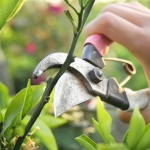
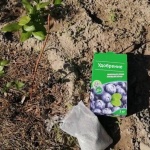
Disease and pest resistance
The shrub is resistant to diseases and pests, therefore it does not need preventive treatments. Powdery mildew, gray mold, anthracnose and moniliosis can be dangerous. When these diseases appear, treatment with fungicides helps.
The most dangerous pests are birds; from them it is necessary to cover the ripening crop with a net. Insects can attack: moth, beetle, leafworm. Large insects are removed by hand, and small and larvae are destroyed with insecticides.
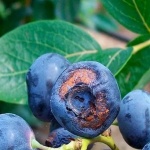
Winter hardiness and the need for shelter
The shrub has very high winter hardiness and frost resistance, it can withstand temperatures down to -37 degrees. To obtain high yields, it is recommended to protect in winter: with burlap, spunbond, a thick layer of snow. Compared to other species, North Country is drought tolerant.

Location and soil requirements
The plant prefers lighted areas, sheltered from the wind. It adapts well to any type of soil. The blueberry variety loves porous and acidic soils, grows well on peat, sand and sandy loam with rotted foliage litter. Fertile black soil is not suitable for this culture. Areas with closely lying groundwater are not recommended; in case of planting, they fill in high beds and equip drainage. Peat and sand must be added to heavy soil.
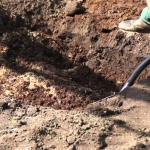
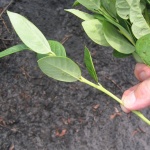
Review overview
Gardeners, when planting blueberries for the first time on the site, often encounter its pickiness to the composition and acidity of the soil: even on fertile soils, the bush begins to wither. The crop appears only with proper planting and caring for the bushes, next to it, other varieties must also be planted. The berries are very tasty, this is a real storehouse of vitamins for the whole family.
